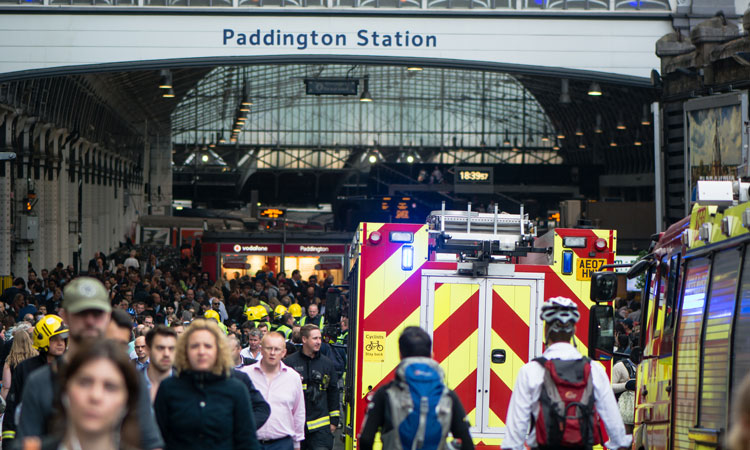How do the UK Fire and Rescue Services work with the rail industry?
Posted: 9 January 2020 | Tony Cash | No comments yet
Tony Cash, International President of the Rail Industry Fire Association (RIFA) provides information to highlight how Fire and Rescue Services work with the rail industry to ensure effective planning in case of fire incidents and the principal role of Fire and Rescue Services at an operational incident.


This article1 has been produced to demonstrate and outline how the Fire and Rescue Services (FRS) in the UK work together with those concerned with the design, construction and operation of railways. Split into two equally important sections, this article covers the requirements for planning of projects (design and construction) and working together at the scene of an incident.
Although written from a UK perspective, it is also applicable as the basis for an understanding of how requirements may be framed for any countries wishing to bolster their response to the growth of rail as a means of transport. The Rail Industry Fire Association (RIFA) will be pleased to discuss the information in this article with any fire service and how it can be adapted for their specific requirements.
Part 1: Working together to ensure effective planning
The rail sector in the United Kingdom has a long tradition of engaging with the Fire and Rescue Services (FRS) to inform each organisation’s planning. Discussions normally involve consultation and review of:
- Recent operational incidents
- Plans for small-scale projects, normally confined to minor changes to a single station, or short-term working on open sections
- Changes to organisations’ policies that may impact on partnership working
- Wider industry or technical changes that may impact on partnership working.
Significant and major projects
Typically, when a project involves the construction of more than one station, a new line or significant ‘sub-surface’ rail construction, it would serve both the railway undertaker and FRS to establish a focused group, examining the impact of hazards and risk involved with the commissioned system as well as construction phases. It is important to note that there must be discussion on the impacts and hazards of the commissioned system to users and FRS personnel.
There must also be due regard for FRS planning in the construction stage(s). In all cases, the FRS will wish to know the integrated intervention and evacuation strategy for dealing with occasions when the FRS are summoned. This should be developed following a HAZOP assessment, which will be a live document and form the basis of control measures to mitigate risk. The following legislation, which is non-exhaustive, will form the legislative outline of the work:
- Regulatory Reform (Fire Safety) Order 2005 (2006)
- Civil Contingencies Act 2004
- Technical Specification for Interoperability (TSI) The Building Act (1984)
- Building Regulations (England & Wales)
- Fire and Rescue Service Act (2004)
- The Health and Safety at Work etc. Act 1974
- Construction (Design and Management) Regulations 2015
- Statutory Instrument 2015
- The Health and Safety (Safety Signs and Signals) Regulations 1996
- Fire Safety (Employee’s Capabilities) (England) Regulations 2010
- The Fire Precautions (Sub-surface Railway Stations) Regulations 2009
In consultation, the FRS will be particularly interested in the following areas:
- Community impact
- Sustainability impact
- Environment
- Access arrangements
- FRS facilities, including water supplies, communications, access arrangements, information gathering at scene and control of hazards
- Incident types and numbers (forecasting for construction stage and commissioned system)
- Impact on business continuity (during planning, construction and commissioning).
A detailed fire engineering exercise known as a Qualitative Design Review (QDR) is normally undertaken as outlined in BS-7974 (Application of fire safety engineering principles to the design of buildings).
The following stages can be summarised as:
- Review of architectural design and occupant characteristics
- Establish fire safety objectives
- Identify fire hazards and possible consequences
- Establish trial fire safety designs
- Identify acceptance criteria and methods of analysis
- Establish fire scenarios for analysis.
The objectives can be summarised as:
- Preservation of life – passengers, staff, contractors
- Provide safe access for Emergency Services during an incident
- Maintenance of railway operations, avoidance of down-time
- If down-time incurred, limit congestion transferred onto other services
- Damage or loss of asset, and damage to surrounding settlements/third parties
- Reputational damage to UK rail and UK overall.
This approach supports industry methodology promoted by Network Rail and the Royal Institute of British Architects (RIBA).
Part 2: Working together at the scene
The principal role of the Fire and Rescue Services (FRS) at an operational incident is to:
- Save life through search and rescue
- Fight fires
- Mitigate damage to property and the environment
- Prevent further harm or loss to people and the infrastructure.
The responding FRS incident commander (IC) will establish an inner cordon. Within this cordon, the IC will direct operations to deliver the role of the FRS.
The FRS will be responsible for identifying hazards and putting appropriate control measures into place. This will require the support of the nominated rail industry representative (the responsible person). The expectation of the FRS incident commander is that the responsible person will put control measures into place, as requested, to control the rail related hazards (for example, electrification and moving rail vehicles). The responsible person’s role is key to the success of the incident. The FRS recognises that it is not feasible to expect the responsible person to be in attendance as the emergency services arrive. Consequently, there should be a means of ensuring that a responsible person can implement control measures remotely, until the representative is on scene.
The significant hazards which the FRS will require support to control at a railway incident include:
- Controlling rail vehicle movements
- Controlling traction current
- Controlling residual risk from traction current
- Controlling other electrical equipment, including signalling
- Gathering information on hazardous materials in transit or related to rail undertaking.
The risk from these hazards can be reduced by:
- Ensuring effective communication can be established with the infrastructure manager (normally through the responsible person)
- Identifying the exact location of where the control measures will apply
- Ensuring that any facilities provided for FRS intervention are available and operating as designed.
The Fire and Rescue Services will respond to requests for assistance. The scale and seriousness of the call will be categorised on the scale and likely impact of the circumstances. The following definitions may be useful to the planner in determining the scale of the fire and rescue response.
An ’incident’ can be defined as2:
- ‘A particular occurrence, especially one of minor importance’
- ‘A usually violent or disruptive occurrence, especially one that precipitates a larger crisis’
- ‘An occurrence that interrupts normal procedure or functioning; a mishap: The plane landed without incident’.
A ‘Crisis/crises’ can be defined as3:
- ‘Abnormal and unstable situation that threatens an organisation’s strategic objectives, reputation or viability’.
An ‘Emergency’ can be defined as4:
- ‘An event or situation which threatens serious damage to human welfare in a place in the United Kingdom’
- ‘An event or situation which threatens serious damage to the environment of a place in the United Kingdom’
- ‘An act of war, or terrorism, which threatens serious damage to the security of the United Kingdom’.
A ‘Major incident’ can be defined as5:
- ‘An event or situation that requires the implementation of special arrangements by one or more of the emergency services. Typically, a Major Incident involves one or more of the following:
- Involvement, either directly or indirectly, of large numbers of people
- The rescue and transportation of a potentially large number of casualties
- The large-scale combined resources of Police, Fire and Rescue and Ambulance Services’.
A ‘Catastrophic incident’ can be defined as6:
- ‘A serious disruption of the functioning of a community or a society involving widespread human, material, economic or environmental losses and impacts, which exceeds the ability of the affected community or society to cope using its own resources’.
Incidents will be managed by the Fire and Rescue Service in a way to minimise disruption to the industry, ensuring the emergency intervention is proportionate and measured to the circumstances at the time.
Further information on National Operational Guidance provided to the UK’s Fire and Rescue Service can be found through the Fire and Rescue Services’ National Operational Guidance Programme, where you will be able to obtain policy information on how incidents are managed.
References:
- The document has been written jointly by UK Fire Brigade personnel and specialist railway fire engineers
- Source: The Free Dictionary
- Source: British Standards Institute
- Source: The Civil Contingencies Act 2004
- Source: The London Emergency Services Liaison Panel (LESLP) 2015
- Source: The United Nations Office of Disaster Risk Reduction.









